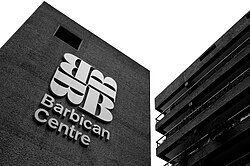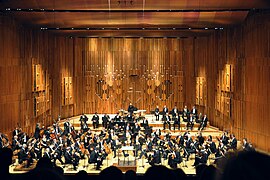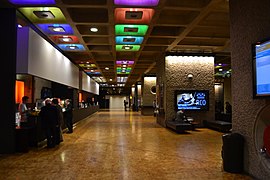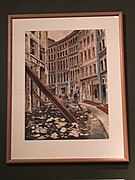Barbican Centre
 | |
 | |
| Address | Silk Street London, EC2 United Kingdom |
|---|---|
| Coordinates | 51°31′13″N 0°05′42″W / 51.5202°N 0.0950°W |
| Public transit | |
| Owner | City of London Corporation |
| Designation | Grade II |
| Type | performing arts centre |
| Capacity | Barbican Hall: 1,943 Barbican Theatre: 1,156 The Pit: 200 |
| Construction | |
| Opened | 1982 |
| Architect | Chamberlin, Powell and Bon |
| Website | |
| barbican | |
The Barbican Centre is a performing arts centre in the Barbican Estate of the City of London, England, and the largest of its kind in Europe.[1] The centre hosts classical and contemporary music concerts, theatre performances, film screenings and art exhibitions. It also houses a library, three restaurants, and a conservatory. The Barbican Centre is a member of the Global Cultural Districts Network.
The London Symphony Orchestra and the BBC Symphony Orchestra are based in the centre's Concert Hall. In 2013, it once again became the London-based venue of the Royal Shakespeare Company following the company's departure in 2001.[2]
The Barbican Centre is owned, funded, and managed by the City of London Corporation. It was built as the City's gift to the nation at a cost of £161 million (equivalent to £718,000,000 in 2023) and was officially opened to the public by Queen Elizabeth II on 3 March 1982. The Barbican Centre is also known for its brutalist architecture.[3]
Performance halls and facilities
[edit]- Barbican Hall: capacity 1,943; home of the London Symphony Orchestra and the BBC Symphony Orchestra.[4]
- Barbican Theatre: capacity 1,156; designed exclusively by and for the Royal Shakespeare Company[2][5]
- The Pit: flexible 200-seat theatre venue
- Barbican Art Gallery and the free new-commission gallery The Curve
- Barbican Film: 3 cinema screens with seating capacities of 288, 156 and 156
- Barbican Library: Public lending library with special collections in arts and music
- Restaurants: 3
- Conference halls: 7
- Trade exhibition halls: 2
- Informal performance spaces
The second-floor library is one of the five City of London libraries. It is one of the largest public libraries in London and has a separate arts library, a large music library and a children's library that regularly conducts free events. The Barbican Library houses the 'London Collection' of historical books and resources, some of which date back to the 18th century, all being available on loan. The library presents regular literary events[6] and has an art exhibition space for hire. The music library has two free practice pianos for public use.
History and design
[edit]
The Barbican Centre had a long development period, only opening some years after the surrounding Barbican Estate housing complex had been finished. It is situated in an area which was badly bombed during World War II.
The Barbican Centre, designed by Peter Chamberlin, Geoffry Powell and Christoph Bon of Chamberlin, Powell and Bon in the Brutalist style, has a complex multi-level layout with numerous entrances. Lines painted on the ground help would-be audience members avoid getting lost on the walkways of the Barbican Estate, within which the centre is located, on the way to it. The Barbican Centre's design – a concrete ziggurat – has always been controversial and divides opinion. It was voted "London's ugliest building" in a Grey London poll in September 2003.[7]
In September 2001, arts minister Tessa Blackstone announced that the Barbican Centre complex was to be a Grade II listed building. It has been designated a site of special architectural interest for its scale, its cohesion and the ambition of the project.[8] The centre was designed by architectural practice Chamberlin, Powell and Bon, who were also responsible for the upscale residential area surrounding the centre (the Barbican Estate), as well as the nearby Golden Lane Estate. Project architect John Honer later worked on the British Library at St Pancras – a red brick ziggurat.
In the mid-1990s, a cosmetic improvement scheme by Theo Crosby, of the Pentagram design studio, added statues and decorative features reminiscent of the Arts and Crafts movement. In 2005–2006, the centre underwent a more significant refurbishment, designed by architects Allford Hall Monaghan Morris and Roger Westman, which improved circulation and introduced bold signage in a style in keeping with the centre's original 1970s Brutalist architecture. That improvement scheme added an internal bridge linking the Silk Street foyer area with the lakeside foyer area. The centre's Silk Street entrance, previously dominated by an access for vehicles, was modified to give better pedestrian access. The scheme included removing most of the mid-1990s embellishments.
Outside, the main focal point of the centre is the lake and its neighbouring terrace. The theatre's fly tower has been surrounded by glass and made into a high-level conservatory.
The Barbican Hall's acoustic has also been controversial: some praised it as attractively warm, but others found it too dry for large-scale orchestral performance. In 1994, Chicago acoustician Larry Kirkegaard oversaw a £500,000 acoustic re-engineering of the hall "producing a perceptible improvement in echo control and sound absorption", music critic Norman Lebrecht wrote in October 2000[9] – and returned in 2001 to rip out the stage canopy and drop adjustable acoustic reflectors, designed by Caruso St John, from the ceiling, as part of a £7.5 mn refurbishment of the hall. Art music magazine Gramophone still complained about "the relative dryness of the Barbican acoustic" in August 2007.[10]
The theatre was built as the London home of the Royal Shakespeare Company, which was involved in the design, but decided not to renew its contract in 2002 after claiming a lack of performing space, plus the artistic director, Adrian Noble, wanting to develop the company's touring performances.[11] The theatre's response was to extend its existing six-month season of international productions, "Barbican International Theatre Event", to the whole year.[12] On 23 January 2013, Greg Doran, RSC artistic director, announced the company's return to the Barbican Centre in a three-year season of Shakespeare's history plays.[13]
In 2017, a new concert hall called the Centre for Music, London was proposed by the Barbican, London Symphony Orchestra, and the Guildhall School of Music and Drama.[14][15] The proposals were cancelled in 2021.[16][17]
The Guildhall School of Music and Drama, where the Barbican Centre theatrical performances are occasionally staged,[18] and the City of London's Barbican Library, neither part of the centre, are also on the site. The Museum of London is nearby at Aldersgate, and is also within the Barbican Estate.
London Australian Film Festival
[edit]The annual London Australian Film Festival (LAFF), supported by the Australian Film Commission (AFC), was formerly held at the Barbican Theatre, from March 1994[19] until the 17th edition in 2011.[20][21] In 2017, the volunteer-run London Australian Film Society founded a new festival, initially named Oz Film Festival but later renamed London Australian Film Festival. Despite the identical name, it has nothing to do with the LAFF at the Barbican, and screenings are held at other cinemas in London.[22][23]
In popular culture
[edit]The Barbican Centre features in Michael Paraskos's novel In Search of Sixpence as the home of the lead character, Geroud, and also a bar called "The Gin Bar" loosely based on the Gin Joint bar at the Barbican Centre.[24]
Bladee's music video for his song Like a Virgin was shot on the grounds of the Barbican Centre.
Gallery
[edit]-
The Barbican Hall of the Barbican Centre
-
The Barbican Centre stage door
-
The Barbican Centre foyer
-
Interior of The Barbican Centre
-
Entrance of The Barbican Centre
-
Shot of The Barbican Centre's ceiling
-
The Barbican Centre at night
-
The entrance to the Barbican Library
-
Jewin Crescent - Barbican before the Barbican
Nearby railway stations
[edit]- Barbican tube station
- Farringdon station
- Liverpool Street railway station
- Moorgate tube station
- St Paul's tube station
See also
[edit]- York Barbican
- Barbicania, a feature-length film by Ila Bêka & Louise Lemoine
- Culture of London
- List of concert halls
References
[edit]- ^ "About Barbican". The Barbican. Archived from the original on 5 October 2007. Retrieved 29 August 2007.
- ^ a b Brown, Mark (10 September 2013). "Royal Shakespeare Company to return to Barbican Centre | Stage". The Guardian. London. Retrieved 10 September 2014.
- ^ Mark Callaghan, Mark (14 November 2013). "Beauty in the Beast: In Defence of Brutalism".Architect Weekly.
- ^ "Venue list: Hall". The Barbican.
- ^ "Venue list: Theatre". The Barbican.
- ^ "City of London Libraries". Archived 23 November 2010 at the Wayback Machine. City of London.
- ^ "Barbican tops ugly buildings poll". BBC News. 22 September 2006. Retrieved 11 January 2007.
- ^ "Listing of the Barbican complex". Archived 8 October 2006 at the Wayback Machine. City of London. Retrieved 11 January 2007.
- ^ Lebrecht, Norman (11 October 2000). "Concert-Hall Blues – Oh for an Acceptable Symphonic Environment". The Lebrecht Weekly. Retrieved 16 August 2007
- ^ August 2007 Gramophone quoted at LSO CD Reviews, on the London Symphony Orchestra's website, undated. Retrieved 16 August 2007. [dead link]
- ^ "RSC ends Barbican era". BBC News. 12 May 2002. Retrieved 31 May 2013.
- ^ Shenton, Mark (22 October 2005). "Barbican box office upsurge follows identity make-over". The Stage. Archived from the original on 6 January 2009. Retrieved 28 November 2007.
- ^ "The Barbican and RSC announce three-year collaboration" (Press release). The Barbican. 23 January 2013. Archived from the original on 2 February 2014. Retrieved 26 January 2014.
- ^ "First concept designs released for London Centre for Music project as next steps announced" (PDF) (Press release). The Barbican. Archived from the original on 17 February 2019.
- ^ "London Centre for Music". Diller Scofidio + Renfro. Retrieved 17 September 2023.
- ^ "City of London Corporation puts culture at the heart of recovery". City of London Corporation. 18 February 2021. Retrieved 18 February 2021.
- ^ Bakare, Lanre (18 February 2021). "City of London scraps plan for 'Tate Modern of classical music'". The Guardian. London. Retrieved 19 February 2021.
- ^ "Silk Street Theatre". Barbican visitor information. Archived from the original on 2 February 2014. Retrieved 26 January 2014.
- ^ "Australian film and television chronology: the 1990s". Australian Screen Online. 29 May 1991. Retrieved 22 January 2024.
- ^ "Little Sparrows selected for London Australian Film Festival". IF Magazine. 18 April 2011. Retrieved 22 January 2024.
- ^ "About the festival". The Barbican. Archived from the original on 24 May 2015.
- ^ "LAF Film Festival". London Australian Film Society. 24 September 2023. Retrieved 22 January 2024.
- ^ "About London Australian Film Society". London Australian Film Society. 20 July 1973. Retrieved 22 January 2024.
- ^ Paraskos, Michael (2015). In Search of Sixpence. (London: Friction Fiction). ISBN 978-0-9929-2478-2.
External links
[edit]- Barbican Estate
- 1982 establishments in England
- Art museums and galleries in London
- Arts centres in London
- Music venues completed in 1982
- Concert halls in London
- Dance in London
- Event venues established in 1982
- Grade II listed buildings in the City of London
- London Symphony Orchestra
- Museums in the City of London
- Theatres in the City of London
- Brutalist architecture in London









